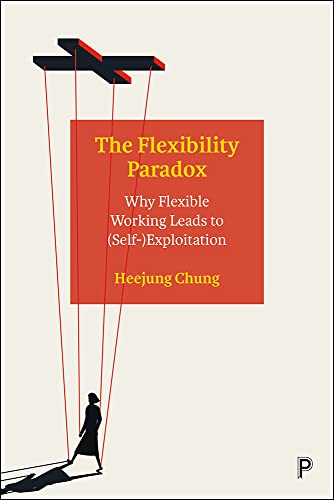The Flexibility Paradox Why Flexible Working Leads to Self Exploitation 1st Edition by Heejung Chung ISBN 9781447354772 144735477X
$50.00 Original price was: $50.00.$25.00Current price is: $25.00.
The Flexibility Paradox Why Flexible Working Leads to Self Exploitation 1st Edition by Heejung Chung – Ebook PDF Instant Download/Delivery: 9781447354772 ,144735477X
Full download The Flexibility Paradox Why Flexible Working Leads to Self Exploitation 1st Edition after payment

Product details:
ISBN 10: 144735477X
ISBN 13: 9781447354772
Author: Heejung Chung
The Flexibility Paradox Why Flexible Working Leads to Self Exploitation 1st Edition Table of contents:
1 Introduction: The flexibility paradox and contexts
Introduction
The contexts
Contexts of the increase in flexible working
Increase in female employment and demand for better work-life balance
Developments in digital technologies
Commuting, and office and travel costs
COVID-19
Contexts of self-exploitation
Always-on culture
Insecurity
Work-centred society
Passion
The book
Flexibility paradox
Background
Outline of the book
How to read this book
Quick word on methodologies
The take-home message
Notes
2 The demand for and trends in flexible working
Introduction
What is flexible working?
Definitions
Flexibility as an arrangement or an approach?
The demand for and provisions of flexible working
The demand for flexible working
Government response to the demand for flexible working to date
European Commission directive on work-life balance
UK
The Netherlands
Italy
Finland
Australia
Korea
Empirical data on the use and provision of flexible working
Provision of flexitime across Europe11
Access to flexible working
Has there been a growth in flexible working?
Conclusion
Notes
3 The dual nature of flexibility: family-friendly or performance-oriented logic?
Introduction
The dual nature of flexible working
Flexible working as a family-friendly arrangement
Flexible working as a high-performance management system
Theories on the determinants of flexible working provision and access
Principle of need/family-friendly demands
Principle of equity/expected performance outcome
Higher status
Bargaining power
Structural factors
Empirical data analysis results
Provision of flexitime – company-level analysis
Access to flexitime/working time autonomy – individual-level analysis
Outside Europe
Conclusion
Notes
4 The outcomes of flexible working
Introduction
Summaries of existing studies
Performance outcomes
Workers’ well-being
Work-life balance
Enhancing employment of mothers and carers
Work-life balance satisfaction
Empirical analysis results
Data and variables
Conclusion
Notes
5 The flexibility paradox: why more freedom at work leads to more work
Introduction
Theories behind the flexibility paradox
Gift exchange, enabled and imposed intensification
Self-exploitation
Organisational culture and self-exploitation
Entreprenurialisation of self and careers
Subjectification of self
Manifestations of the paradox: passion at work as the basis for self-exploitation
Passion
Busyness as a badge of honour
Passion paradox
Millennial burnout
Conclusion
Notes
6 The empirical evidence of the flexibility paradox
Introduction
Evidence of flexible working and longer working hours
Association between flexible working and long hours of work
Flexible working leading to long hours of work
Flexible working, mental spill-over and additional work effort
Differences across groups of individuals
Gender and parental status
Occupational variations
Arrangement variations?
Conclusion
Note
7 Gendered flexibility paradox
Introduction
Background context of the gendered nature of the flexibility paradox
Subjectification of self and the family
Intensive parenting
Intensive mothering and gender norms
Gendered flexibility paradox
Flexible working and the expansion of unpaid work
Empirical evidence of the gendered flexibility paradox
Exploitation model and traditionalisation of gender roles through flexible working
Class variations or arrangement variations?
Gendered nature of flexible working and access to flexible working
Conclusion
Notes
8 Flexibility stigma and the rewards of flexible working
Introduction
Flexibility stigma and its prevalence
Defining flexibility stigma
Prevalence of flexibility stigma
Flexibility stigma and gender
Femininity stigma
Rethinking the gendered stigma
Evidence of the gendered flexibility stigma
Conclusion
9 The importance of contexts
Introduction
Which contexts matter?
Work centrality
Gender norms
Family and social policy
Workers’ bargaining powers
Economic and labour market conditions
Prevalence of flexible working
Empirical evidence of the impact of national contexts
Provision of flexible working2
Use and access to flexible working
Flexibility stigma
Outcomes of flexible working4
Conclusion
Notes
10 COVID-19 and flexible working
Introduction
COVID-19 context
COVID-19 global context
COVID-19 context in the UK
Flexible working during the pandemic
The prevalence of working from home during the pandemic
Changing the perception towards flexible working
Managers’ perception
Employees’ perception
Outcomes of flexible working during the pandemic
Long-hours work
Blurring of boundaries
Reduction of hours
The division of household labour and childcare
Conclusion
Notes
11 Conclusion: Where do we go from here?
Introduction
Future scenarios of flexible working
Are we going to see a rise in flexible working?
Will flexible working be accessible for everyone in the future?
Will flexible working help tackle gender equality in the future?
What are the implications of flexible working on workers’ well-being?
What do we need to do? Policy recommendations for governments
Better rights and protection for flexible workers
Reshaping normative views around work-life balance and gender
Changing the long working hours culture
Recommendations for companies and managers13
Redefining productivity and KPIs
Ensuring a clearer boundary between work and non-work spheres
Removing the stigma around flexible working for care purposes
Recommendations for individuals and families
Maintaining clear boundaries
Gender division and housework, childcare
Doing less
Conclusion
Notes
Data used
European Company Survey 2013
European Working Conditions Survey 2015
Variables: European Working Conditions Survey
1643964843593_187
Flexitime, working time autonomy and schedule control
Teleworking/home working
Work-to-family, family-to-work conflict variables
Spill-over, work during free time variable
Work-family conflict index for Chapter 9
Control variables; access to and use of flexible working models
Control variables; work-family conflict models
Appendix Figures and Tables
Appendix to Chapter 3
Appendix to Chapter 4
Appendix to Chapter 6
Appendix to Chapter 9
Appendix to Chapter 10
COVID-19 data sets
UK
US
Canada
Australia
The Netherlands
Germany
Cross-European
Appendix
Data used
European Company Survey 2013
European Working Conditions Survey 2015
Variables: European Working Conditions Survey
Flexitime, working time autonomy and schedule control
Teleworking/home working
Work-to-family, family-to-work conflict variables
Spill-over, work during free time variable
Work-family conflict index for Chapter 9
Control variables; access to and use of flexible working models
Control variables; work-family conflict models
People also search for The Flexibility Paradox Why Flexible Working Leads to Self Exploitation 1st Edition:
why does stretching make you flexible
why is flexibility important in the workplace
why is flexibility particularly valued in the modern workplace
the flexibility paradox why flexible working leads to (self-) exploitation
flexibility is the key
Tags: Heejung Chung, Flexibility Paradox, Self Exploitation, Working Leads
You may also like…
Physics - Quantum Mechanics
The Quantum Nature of Things How Counting Leads to the Quantum World 1st Edition T R Robinson
Computers - Artificial Intelligence (AI)
From Opinion Mining to Financial Argument Mining 1st Edition Chung-Chi Chen
Earth Sciences - Geology
Business & Economics - Sales & Marketing
Business & Economics - Markets
Beyond Self-Interest: Why the Market Rewards Those Who Reject It 1st Edition Krzysztof Pelc
Uncategorized











